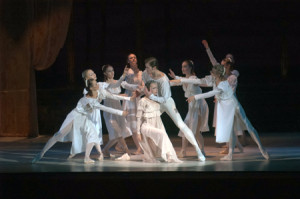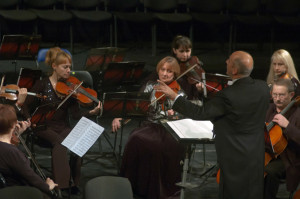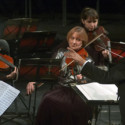A deep understanding of the artistic process gives composers, choreographers, dancers, actors, directors, musicians, and visual artists the distinct 21st century advantage of serving in the role of problem solvers. Artists learn to stretch boundaries and forge new partnerships, often making insightful contributions to intellectual inquiry and the strengthening of communities. Much of the understanding comes from collaborative artistic processes. It’s powerful.
 I recently saw a performance of a work choreographed by Mark Morris. The work—Canonic ¾ Studies—was delightful. It playfully pokes fun at classical ballet while still utilizing traditional steps and positions. The end of the work features a joyful circle dance in which the joy is associated with the shared activity of dancing together. In the works of Morris, his composition often serves as a means for a group to engage with music together.
I recently saw a performance of a work choreographed by Mark Morris. The work—Canonic ¾ Studies—was delightful. It playfully pokes fun at classical ballet while still utilizing traditional steps and positions. The end of the work features a joyful circle dance in which the joy is associated with the shared activity of dancing together. In the works of Morris, his composition often serves as a means for a group to engage with music together.
I build duets into bigger works. I like to see people working together. What we call a giant solo in my company is about four bars long while twenty other people are doing something dynamically. I like the charge that is set up by a lot of people doing something.
~ Mark Morris
 Performers in bands, orchestras, choirs, jazz, and chamber ensembles learn to engage in a creative process where musical ideas are both produced and evaluated in the performance itself. Perhaps the most intimate experience of collaboration occurs in musical communication and interactions between a solo performer and an accompanist. Whether through choreography or music ensemble performance, the artistic process requires a powerful connection as a community. The performers learn to work together, breathe together, and move together. The end result is a beautiful work of art—a result that is much more than what could have been accomplished by one person.
Performers in bands, orchestras, choirs, jazz, and chamber ensembles learn to engage in a creative process where musical ideas are both produced and evaluated in the performance itself. Perhaps the most intimate experience of collaboration occurs in musical communication and interactions between a solo performer and an accompanist. Whether through choreography or music ensemble performance, the artistic process requires a powerful connection as a community. The performers learn to work together, breathe together, and move together. The end result is a beautiful work of art—a result that is much more than what could have been accomplished by one person.
I like the idea of collaboration—it pushes you. It’s a richer experience…
~ Frank Gehry
Many thought leaders believe that collaboration—teamwork—is the driving force behind growth and innovation in the 21st century. Whether in our work environments, families, or communities, we can all use the artistic process to develop skills of openness, knowledge sharing, focus, and accountability.
The collaborative artistic process that we can all learn to use in our daily lives will help us achieve many skills that are vital to success and happiness in contemporary society.
Coming together is a beginning; keeping together is progress; working together is success.
~ Henry Ford
A few of the benefits include:
[sws_checklist]
- Awareness as a part of a team or community with a shared purpose
- Reflective thinking that considers alternatives
- Motivation to solve problems and achieve consensus
- Developing trust in others
- Learning the methods of others and working fluidly across boundaries
- Communicating with the expectation of receiving and sharing in return
[/sws_checklist]
Philosopher Alan Watts once said, “The only way to make sense out of change is to plunge into it, move with it, and join the dance.” Dramatic changes are taking place in the world. What an incredible opportunity we have to learn to think like artists, using the artistic process to dance together and live more productive joyful lives.
— Pat
